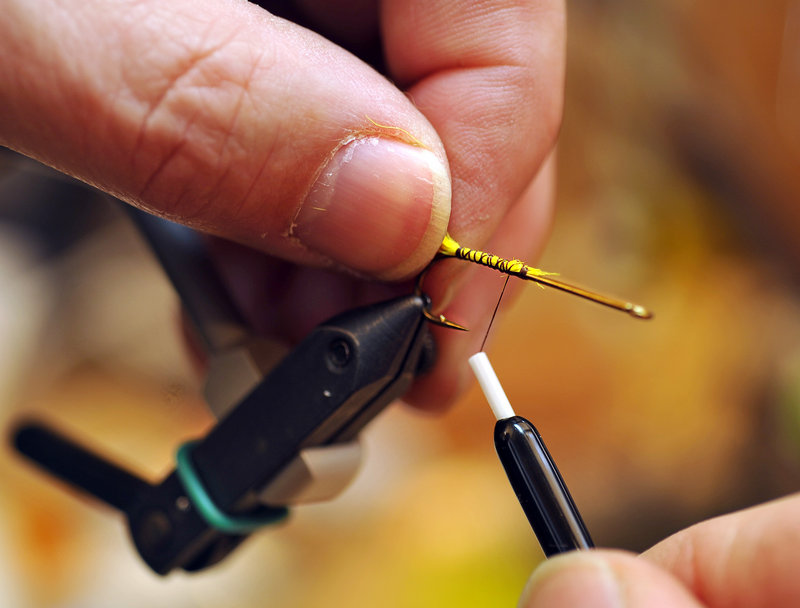Each New Year’s holiday, a question pops to mind, but unfortunately, no one has collected statistics for a definitive answer.
How many Mainers tie flies each winter?
Tiers in this state must number in the five-figure range, and our tying “season” usually begins about now. My tying often kicks off on New Year’s Eve, a much safer pastime than driving to parties or restaurants when vehicle operators are more apt to be impaired.
Maine’s fly-tiers must outnumber waterfowl, rabbit or upland-bird hunters with dogs or general enthusiasts after bears. Only anglers and deer and grouse hunters beat the tier population.
Each winter, in this unofficial sport, folks sit inside and tie while dreaming of blue water and verdant shores. Then while fishing, we look at our flies and may remember the exact day of tying them.
The Internet really adds to this pastime, too, because folks can find most dressings for most of the flies of the world. What a resource.
It’s fun to peruse fly-fishing catalogs to see what flies made the pages of say Orvis or Bean publications. Last spring, the Freeport icon listed blue-winged olive (BWO) patterns first, and the Orvis summer catalog did, too.
For some reason, my Orvis summer catalog arrived a few days before I wrote this column, and two points really caught my eye:
First, blue-winged olive photos lead off the dry fly and emerger selections, which still intrigues me after all these years of seeing these flies first. Here’s why. When I was in my 20s, a few Mainers like me had read Art Flick’s “Streamside Guide” and had dutifully tied BWO variants a la Flick, but most people hadn’t heard of BWOs and didn’t notice them on the water.
The second point really wows me. These days, as catalogs illustrate, BWOs have catapulted into our consciousness, and at this very moment, I’ll wager myriad tiers are constructing one right now while dreaming of spring 2011.
Different species and genera of BWOs hatch from late April though November, depending on latitude and elevation, offering a very long hatching season. It’s little wonder BWOs have exploded in popularity.
In the summer Orvis catalog, the editor listed the first two flies under the designation of “top fly,” and they were a BWO Parachute and blue-winged olive classic dry in sizes 14 though 22. Then the catalog offered 14 other BWO patterns following those two.
Why so many?
First, BWO hatches include a variety of sizes and varying shades of olives and blue-grays, explaining why Orvis provided 16 choices.
Second and more importantly, an observable fact often occurs in a BWO hatch on my home river. If I catch a trout on a BWO Compara-dun and release it, that fish probably won’t hit a Compara-dun again for 10 to 14 days. If I switch to a BWO Thorax style, that fly may entice the fish to strike again. The change to a different pattern continues with each success. After a couple weeks, the trout may hit the Compara-dun again — or maybe not.
These catalogs offer new, innovative salmonid patterns that stick out enough as fish catchers to list for sale, including Deer Hair Emerger, Low Rider CDC & Elk Caddis, Tentwing Black Caddis, Czeck-Mate Hare, Cream, Czeck-Mate Caddis, Purple Haze, Senyo Wiggle Stone and Easy on the Eyes Emerger — all of them on the Internet.
Often, one pattern — such as the Lightening Bug with lots of bright materials — appeals to novice fly rodders. I’ve had bad luck with gaudy flies, though, and one incident occurred with the Holy Grail in the mid-1990s.
First, though, who can resist a fly with such a name? Not I. I bought one at Fly Fishing Only in Fairfield to duplicate more of them at my vise.
However, my first cast with a Holy Grail landed ultra-softly just upstream of a famous central Maine brook trout about 24 inches long. The fly instantly frightened this monster brookie into shadows beyond sight.
Here’s a salient thought on fly patterns, too. New inventions that fish haven’t seen generally work better than ones that everyone is using. In short, some flies, such as Jerry’s Smelt, West Branch Caddis and tan Elk Hair Caddis, once worked wonders for me, but they slowed down when their popularity made them common fly choices on my waters.
Jerry’s Smelt and West Branch Caddis are nowhere near as popular now as they were in the 1980s and early 1990s, so they have worked better for me as of late. I suspect fish get stung on a certain pattern, and this makes them reluctant to hit again.
Fly-tying season hits full swing now, so folks are sitting at their vises until warming spring days or winter thaws draw them streamside. This lethargic sport and gym workouts keep many Mainers sane through the white, cold season.
Ken Allen of Belgrade Lakes is a writer, editor and photographer. He can be contacted at:
KAllyn800@yahoo.com
Send questions/comments to the editors.



Success. Please wait for the page to reload. If the page does not reload within 5 seconds, please refresh the page.
Enter your email and password to access comments.
Hi, to comment on stories you must . This profile is in addition to your subscription and website login.
Already have a commenting profile? .
Invalid username/password.
Please check your email to confirm and complete your registration.
Only subscribers are eligible to post comments. Please subscribe or login first for digital access. Here’s why.
Use the form below to reset your password. When you've submitted your account email, we will send an email with a reset code.